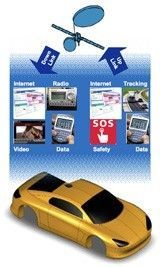
-
StatusCompleted
-
Status date2013-05-17
-
Activity Code7B.015
In the frame of this activity, low cost S-Band Rx/Tx antennas for vehicular applications have been developed. The activity aims at a pre-series development of antenna units to be installed on cars for exploiting S-band DVB-SH system capabilities.
Two antenna types have been developed: Rx only antenna type and Tx/Rx antenna type. The Rx antenna type is a sub-product of the Tx/Rx type. The Tx/Rx antenna embeds four radiators for S-band: SAT Rx, S-band SAT Tx, GSM/UMTS and GPS and relevant RF Front-Ends. These antennas have been already used in the field in the frame of the SOLARIS/Eutelsat W2A experimentation.
The objective of the activity was to develop a low cost, miniaturised antenna unit for automotive applications suitable for S-band Mobile Satellite Systems based on DVB-SH and in particular suitable for the systems of the two European S-band licensees Solaris Mobile and Inmarsat.
The antenna has small dimensions and has aesthetically designed for installation on automobiles. The antenna implements a conical shaped beam and a very efficient active chain that maximises the reception of DVB-SH signal all over Europe.
Two different types of antennas were developed, one for Receiveonly systems (only broadcasting services) and one for bi-directional systems (including return channel). Both antennas are suitable for the reception of positioning systems (GPS), terrestrial communications (GSM, UMTS) and S-band CGC (Complementary Ground Components).
The multisystem antenna together with the respective satellite transceivers and applications allows the deployment of safety, logistics, communication and broadcast services in a pan-European coverage.
Figure 1 – Overview of the targeted services.
The key issues addressed in this project are:
- Design of a compact multi-system antenna taking into account all coupling and interferences issues,
- Collaborate with DVB-SH system engineers to refine return channel specifications and transmit/receive antenna requirements,
- Implement a low-cost antenna design and manufacturing process,
- Work on marketing and distribution of a bundled solution (transceiver + antenna).
This project has provided a major contribution to the development of a multisystem antenna integrating capabilities for bidirectional mobile satellite system and specifically designed for the car market.
The resulting antenna has the following main advantages:
- Dedicated beam shape - With respect to typical omnidirectional antennas used in SDARS or navigation systems, in this development the S-band radiating element will be designed to generate a conically shaped beam that maximises the gain of the antenna at the medium and low elevation angles. These directions are required to ensure a good European coverage especially for northern countries.
- Bi-directional satellite link – The antenna will integrate functionalities for bi-directional satellite links in a single compact packaging. The availability of a satellite return channel will enable or improve several new services in the field of Intelligent Transportation Systems.
- Compact dimensions – The antenna will integrate Satellite and Terrestrial communication systems as well as navigation systems in a compact shape suitable for installation on modern cars.
- Low-cost – Despite the complexity, the antenna will be low-cost, thus enabling the consumer market.
The most significant achievements of the projects are:
- Two types of antennas have been designed.
i) The Tx/Rx type integrates up to 4 different elements to cover the S-Band SAT and TER Systems at Rx and Tx bands, terrestrial mobile network frequencies, and the GPS band.
ii) The second type of antenna (Rx-Only) is composed of 3 elements, covering Rx SAT and TER frequencies
- The design of both antennas has targeted not only for the commercialization of vehicular systems. Both antenna types also cover Maritime and Rail System commercialization. The implemented design also allows an easy mounting on various platforms.
- The antennas are ready for commercialization and sample units are available to support marketing activities. The antennas have already been used in demonstrations of real applications by a consortium of service provider and final users. The demonstrations have shown several applications spanning from broadcasting of multimedia information, messaging services for vehicles tracking alerts and M2M communications up to bidirectional real-time communications for voice communication and video streaming from the vehicles.
- This large spectrum of applications is enticing a lot of interest from ITS actors and first commercial services are foreseen to start in a near future. JAST is ready to support system integrators and service providers in the deployment of commercial services and further customization on shape, size and packaging of the antennas are possible to fulfill specific customer needs.
The multisystem antenna to be developed satisfied very different requirements going from bi-directional link with a Geostationary satellite to multi-band terrestrial networks. The integration of such different systems working with signals at very different power levels requires a dedicated antenna design to minimise coupling and interferences between the systems. The antenna is composed of different radiating elements that are tightly integrated to minimise the overall size of the antenna.
The Receive-only antenna is composed of three elements: one for S-band receive band, one for GPS and one for GSM/UMTS bands. The Transmit/Receive antenna in addition integrates a separate element for S-band return link operations.
The receive antennas integrates RF low-noise amplifiers to maximise the reception quality. Custom filters are also integrated in the active chain to reduce out-of-band noise as well as interferences from other systems. The two types of antennas are assembled with a custom low-profile aesthetic radome suitable for mounting on cars.
The activity is composed of two main phases. The first phase has been dedicated to the following activities:
- State-of-the-Art review of radiating elements and RF components
- Antenna architecture and implementation trade-off.
- Preliminary Antenna Design and Critical breadboards manufacturing and validation
- Final Antennas Design
The second phase has included the following activities:
- Prototype Manufacturing
- Prototype Testing and design refinement
- Industrialisation of the antenna design and definition of production testing procedures
- Production of Pre-series antennas
- Testing of Pre-series antennas
- Refinement of production and testing procedures
The project has been successfully completed.




